Imphal
(/ˈɪmfəl/) is the capital city of the Indian state of Manipur. The metropolitan centre of the city contains the ruins of Kangla Palace (also known as Kangla Fort), the royal seat of the former Kingdom of Manipur, surrounded by a moat. Spread over parts of the districts of Imphal West and Imphal East, the former contains the majority of the city’s area and population. Imphal is part of the Smart Cities Mission under the Ministry of Housing and Urban Affairs.
History
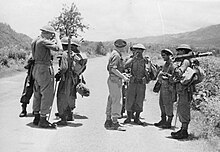
Soldiers of the two wings of the 14th Army link-up at Milestone 109 during the Battle of Imphal-Kohima
Initially ruled by Kin Khaba, Imphal was later ruled by the Pakhangba leaders. The clan of the Ningthouja tribe originated then. The Ningthouja tribe quickly expanded and dominated the region in politics and war. Kangla Palace was built by King Khagemba and his son Khunjaoba. The palace was later destroyed by the British during the Anglo-Manipur War. During the reign of Maharaja Bhagyachandra, there were a number of Burmese invasions. However, the kingdom survived with the help of Maharaj Gambhir Singh.
Imphal remained peaceful until 1891, when there were internal differences in the royal family. The British sent J.W. Quinton to help but the situation only grew worse and Senapati Tikendrajit was hanged. The autocratic British behavior made people angry. This resulted in the 1891 Anglo-Manipur War, which the British won.
The Battle of Imphal took place between March and July 1944, during World War II. The Japanese had invaded Imphal to destroy Allied forces and then invade India, but they were defeated and forced to retreat. The attack made the British realise the militarily strategic position of Imphal.
Demographics
Imphal city is divided between the two districts of Imphal West and Imphal East. Census collects the information for the two parts of the city separately, with the major portion of the city being in Imphal West and the minor portion in Imphal East.
| Area | District | Total Population | Sex Ratio | Literacy Rate | Percentage of Scheduled Caste Population | Percentage of Scheduled Tribe Population |
|---|---|---|---|---|---|---|
| Imphal ( Major part) | West Imphal | 193,459 | 1048 | 91.7% | 0.56% | 8.59% |
| Imphal ( Minor part) | East Imphal | 83,737 | 1062 | 88.71% | 0.24% | 15.71% |
Geography and climate
| Imphal | ||||||||||||||||||||||||||||||||||||||||||||||||||||||||||||
|---|---|---|---|---|---|---|---|---|---|---|---|---|---|---|---|---|---|---|---|---|---|---|---|---|---|---|---|---|---|---|---|---|---|---|---|---|---|---|---|---|---|---|---|---|---|---|---|---|---|---|---|---|---|---|---|---|---|---|---|---|
| Climate chart (explanation) | ||||||||||||||||||||||||||||||||||||||||||||||||||||||||||||
|
||||||||||||||||||||||||||||||||||||||||||||||||||||||||||||
|
||||||||||||||||||||||||||||||||||||||||||||||||||||||||||||
Imphal is located at 24.8074°N 93.9384°E in extreme eastern India, with an average elevation of 786 metres (2,579 ft). It has a humid subtropical climate (Köppen: Cwa) with mild, dry winters and a hot monsoon season. Temperatures in July average about 29 °C (84 °F); January is the coldest month, with average lows near 4 °C (39 °F). The city receives about 1,320 mm (52 in) of rain, with June the wettest month. The highest recorded temperature was 35.6 °C (96.1 °F), on 22 May 2009, and the lowest temperature was −2.7 °C (27.1 °F) on 10 January 1970.
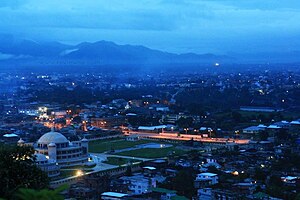
Imphal city nightview
| hideClimate data for Imphal (1981–2010, extremes 1953–present) | |||||||||||||
|---|---|---|---|---|---|---|---|---|---|---|---|---|---|
| Month | Jan | Feb | Mar | Apr | May | Jun | Jul | Aug | Sep | Oct | Nov | Dec | Year |
| Record high °C (°F) | 27.8 (82.0) |
32.0 (89.6) |
35.0 (95.0) |
34.5 (94.1) |
35.6 (96.1) |
35.6 (96.1) |
35.7 (96.3) |
34.0 (93.2) |
34.5 (94.1) |
34.2 (93.6) |
30.7 (87.3) |
28.9 (84.0) |
35.7 (96.3) |
| Average high °C (°F) | 22.4 (72.3) |
24.2 (75.6) |
27.2 (81.0) |
28.5 (83.3) |
29.2 (84.6) |
29.6 (85.3) |
29.4 (84.9) |
29.7 (85.5) |
29.5 (85.1) |
28.7 (83.7) |
25.9 (78.6) |
22.9 (73.2) |
27.3 (81.1) |
| Average low °C (°F) | 4.6 (40.3) |
7.7 (45.9) |
12.1 (53.8) |
15.8 (60.4) |
18.7 (65.7) |
21.3 (70.3) |
21.9 (71.4) |
21.7 (71.1) |
20.6 (69.1) |
17.2 (63.0) |
11.1 (52.0) |
6.1 (43.0) |
14.9 (58.8) |
| Record low °C (°F) | −2.7 (27.1) |
−1.4 (29.5) |
2.4 (36.3) |
6.2 (43.2) |
11.1 (52.0) |
14.7 (58.5) |
15.4 (59.7) |
14.6 (58.3) |
14.3 (57.7) |
7.8 (46.0) |
1.5 (34.7) |
−1.7 (28.9) |
−2.7 (27.1) |
| Average rainfall mm (inches) | 11.5 (0.45) |
43.4 (1.71) |
81.2 (3.20) |
154.6 (6.09) |
174.3 (6.86) |
221.6 (8.72) |
231.4 (9.11) |
186.8 (7.35) |
157.2 (6.19) |
122.3 (4.81) |
34.7 (1.37) |
17.8 (0.70) |
1,436.7 (56.56) |
| Average rainy days | 1.1 | 3.3 | 6.1 | 10.3 | 11.8 | 15.4 | 16.1 | 12.9 | 10.2 | 7.3 | 2.4 | 1.0 | 97.9 |
| Average relative humidity (%) (at 17:30 IST) | 60 | 54 | 53 | 62 | 69 | 77 | 79 | 79 | 80 | 78 | 74 | 70 | 70 |
| Source: India Meteorological Department | |||||||||||||
Government and politics
Imphal is the state capital as well as the headquarters of the Imphal district. The civic administration of the city is under Imphal Municipal Corporation.
Civic administration
According to Census 2011, Imphal constitutes 42.13% of the total urban population in Manipur. Hence, the history of urban local governance is longer in Imphal than in other parts of the state. The British established the Town Fund Board in Imphal in 1915, which was headed by the then Political Agent Lt. Col. H.W.G. Cole and other nominated members. The Town Fund Board continued after Independence and merger with India in 1949 and it was not headed by the Chief Secretary of Manipur Administration. In 1956, the Assam Municipal Act, 1923 was extended to Manipur and the Imphal Municipal Board was formed with 12 elected members. The strength of the elected members of this Board was increased to 24 in 1961 and to 28 in 1972. Initially, the Municipal Board was established only to administer the areas in Imphal under the British Reserve, covering 3.10 km2 (1.20 sq mi) and 2,862 inhabitants. This was extended to 17.48 km2 (6.75 sq mi) in 1960, 18.25 km2 (7.05 sq mi) in 1970, and 76.58 km2 (29.57 sq mi) in 1972.
In 1992, the Municipal Board was upgraded to a Municipal Council under the Manipur Municipality Act, 1994. In 2014, the council was upgraded to the status of Municipal Corporation. There are 27 wards under the Municipal Corporation, each with its own elected councillor. There are eight committees and five sections at the corporation to govern the administration of the city.
There are Ward Development Committees in each ward to look after developmental activities at the ward level. The local ward councillor is the chairperson of the committee, which includes two elected and two nominated members as well. The last election to the corporation was in 2016, with INC winning 12 seats, BJP winning 10 seats, and independent candidates winning 5 seats. According to the Manipur Municipality Act, 1994, the mayor is indirectly elected by the elected councillors from amongst themselves. The first mayor of the corporation was Soram Sunil and was elected in 2016. The present mayor of Imphal Municipal Corporation is Laisangbam Lokeshwar and was elected to the position in 2017. Sujata Phaomei is the present Deputy Mayor.
Representation in parliament
Manipur is divided into two constituencies for the purpose of Lok Sabha – Outer Manipur Parliamentary Constituency and Inner Manipur Parliamentary Constituency. Imphal city is part of the Inner Manipur Parliamentary Constituency. The last elections took place during the 2019 Indian general elections. Rajkumar Ranjan Singh from the Bharatiya Janata Party won the election with 2,63,632 votes.
Civic amenities
Manipur State Power Distribution Company Limited is responsible for electricity supply in the city. Public Health and Engineering Department of the Manipur Government looks after both water supply, and sewage and drainage in Imphal. Roads in the city are developed and maintained by the state Public Works Department. Imphal Municipal Corporation is responsible for Solid Waste Management. The state Department of Fire Services provides fire safety services in the city with one fire station, which is also the department headquarters.
Tourist attractions
Imphal offers sites of religious and historical importance within and around the city. Kangla Palace (also known as Kangla Fort) is on the banks of the Imphal River. Kangla means “dry land” in the Meitei language. It was the palace of King Pakhangba, and has religious significance with multiple temples present within the complex. It is also significant in Manipur’s history with the British. Bihu Loukon is an ancient star-shaped fort made of mud situated in Maklang, Imphal West District. It was discovered in 2013. Hiyangthang Lairembi Temple is religious site important to both the local religion, Sanamahism, and to Hinduism. The temple is noted for its annual Durga Puja festival.
India Peace Memorial at the Red Hills is located 12 km (7.5 mi) south of Imphal. The place was the scene of action and the theater of the battle that took place between the British Army and the Japanese Forces fighting alongside the Indian National Army in World War II. Red Hill has now become a tourist attraction since the Japanese war veterans constructed a monument at the foot of this hill. The Imphal War Cemetery remembers Indian and British soldiers who fought and died in 1944 during World War II and is managed by the Commonwealth War Graves Commission.
Imphal is also home to the largest all women run market in Asia, called the Ima Keithel (Mothers’ Market). It was established in the 16th century and hosts around 5,000–6,000 women vendors who sell a variety of products.
-

A pair of Kangla Sha dragons at Kangla Fort
-

Bamboo huts in Kangla Fort complex
-

Kangla Fort Complex
-

Ruins of Kangla Fort
-

Kangla Museum houses
-
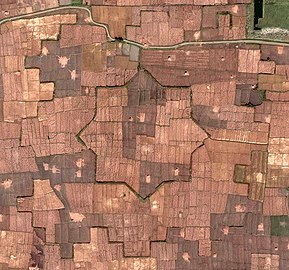
Bihu Loukon aerial view
-
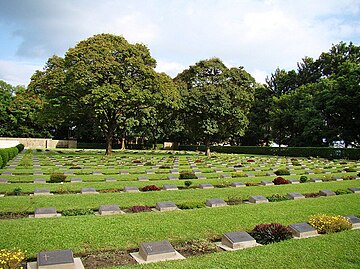
Imphal War Cemetery
-

Women’s Market (Ima Keithel)
Transport
Air

Bir Tikendrajit International Airport
Tulihal International Airport is 8 kilometres (5.0 mi) south of the city and has direct flights to major Indian cities.
Road

National Highway 150 in Imphal
Imphal is connected by the National Highway to major cities like Guwahati, Kohima, Agartala, Shillong, Dimapur, Aizawl, and Silchar.
Railway
In October 2012, India’s Cabinet Committee on Infrastructure approved an extension of the Jiribam–Silchar railway to Imphal. The extension was expected to reach the city by 2019. The total length of the railway line is 110.62 km. The revised estimated cost of construction for the railway line sits at Rs 9658 crore, with Rs 4927.54 crore being spent as of 2019.
Sports
Khuman Lampak Main Stadium is a multi-purpose stadium in Imphal. It is used mostly for football and athletics. The stadium holds 30,000 people and was built in 1999. This stadium lies inside the Khuman Lampak Sports Complex. Imphal based professional football clubs NEROCA FC and TRAU FC of I-League play their home matches at this stadium.
Education
Universities
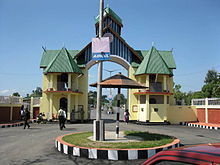
Manipur University main gate
- Manipur Central University
- Central Agricultural University
- National Sports University
- Manipur University of Culture
Technical colleges
- Indian Institute of Information Technology, Manipur
- Manipur Institute of Technology
- National Institute of Technology, Manipur
- Manipur Technical University
Medical colleges
- Regional Institute of Medical Sciences
- Jawaharlal Nehru Institute of Medical Science

City Convention Centre
Schools
There are many schools in Imphal affiliated with the Central Board of Secondary Education and Indian Certificate of Secondary Education Board, as well as state government schools.
- Areca School, Ragailong
- Catholic School, Canchipur
- Comet School, Changangei
- Dav Public School, Chingmeirong
- Don Bosco School Imphal, Chingmeirong
- Guru Nanak Public School
- Herbert School
- Jawahar Navodaya Vidyalaya, Khumbong (Imphal west), Imphal east, Bishnupur, CCpur, Ukrul, Thoubal, Tamenglong and Senapati
- Johnstone Higher Secondary Public School
- Kids’ Foundation School, Ghari
- Maria International Montessori School, Koirengei
- Meci Explorer Academy Changangei
- Kendriya Vidyalaya No 1 Imphal, Lamphelpat
- Kendriya Vidyalaya No 2 Imphal, Langjing
- Little Flower School
- Lodestar Public School
- Manipur Public School
- Sainik International School & College Imphal
- Savio English Higher Secondary School, Thangmeiband
- St. Anthony’s English School & College Imphal
- St. John English High School, Nambol, Bishnupur District
- St. Joseph School
- St. Paul’s English School
- Sanfort International School & College Imphal
- Sangai Higher Secondary Public School
Healthcare
Imphal has many private and government hospitals that are open 24 hours.
- Regional Institute of Medical Sciences
- Shija Hospitals & Research Institutes
- City Hospital
- Imphal Hospital
- Raj Medicity
- Sky Hospital and Research Institute
- Mother’s Care Hospital and Research Centre
- Apex Hospital
- Jawaharlal Nehru Institute of Medical Sciences
- Horizon Hospital and Research Institute
- Advanced Hospital
- Catholic Medical Centre
- Maipakpi Maternity and Child Hospital
- Iboyaima Hospital
- Asian Hospital
- Lamjingba Hospital
Notable people
- M. K. Binodini Devi, novelist, short story writer, playwright and a member of the royal family of Manipur
- Yumlembam Gambhini Devi, recipient of the 1988 Sangeet Natak Akademi Award and the Padma Shri in 2005 for her contributions to Manipuri dance and music
- Ngairangbam Bijoy Singh, doctor and politician
- Ratan Thiyam, theatre director and chairman of the Imphal Chorus Theatre, former chairman at National School of Drama
- Neelamani Devi, craftswoman and master potter who was awarded the Padma Shri in 2007 for her contributions to the art of pottery making
- Mary Kom, boxer and national representative at world sports events
- Dingko Singh, boxer who won a gold medal at the 1998 Asian Games and was awarded the Padma Shri in 2013
- Binalakshmi Nepram, humanitarian, author, and female activist for gender rights and women-led disarmament movements in Manipur and northeast India
- Irom Chanu Sharmila, also known as the “Iron Lady” or “Mengoubi” (“the fair one”), a civil rights activist, political activist, and poet
- Robert Naorem, designer representative of indigenous designs of Manipur and involved in the Hindi film industry
- Dheeraj Singh Moirangthem, footballer
- Bombayla Devi Laishram, archer who was awarded the Arjuna Award in 2012 and the Padma Shri in 2019 by the Government of India for her contributions to sports
- Armstrong Pame, Indian Administrative Service officer
